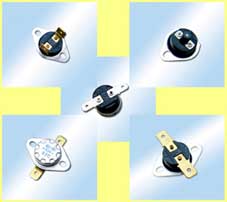Thermal switch characteristics
Thermal switch Operation Principle
KSD301 snap action Thermal switch series is a small-size bimetal thermostat series with a metal cap, which belongs to thermal relays’family. The main principle is that one function of bimetal discs ls snap action under the change of sensing temperature. The snap action of disc can push the action of the contacts through the inside structure, then caused on or Off of the circit finally. The main characteristics are the fixation of working temperature, the reliable snap action, less flashover, longer working life and less radio interfernce
Cautions:
1. The Thermal switch should work in environments with humidity not higher than90%. free of caustic. flammable gas and conducting dust.
2. When the Thermal switch is used to sense the temperature of solid items. its covel should be clung to the heating part of such items. Meanwhile. heat-comducting stilicon grease or other media of similar nature should be applied in to the cover surface.
3. The top of the covel must not be pressed to sink or be distored so as to avoid adveres effect on the Thermal switch’s temperature sensitivity or its other functions.
4. Liquids must be kept out of the Thermal switch’s inner part, The base must avoid any foree that could lead to crack;it should be kept clear and away from the pollution of electric substance to prevent insulation weakening that leads to shortclrcuited damages.
Technical Apecmcations:
Electric Ratings:AC250V 5A/AC120V 7A(Resistive load)
AC250V 10A(Resistive load)
AC250V 16A(Resistive load)
Electric Strength:No breakdown and flashover underAC 50Hz 2000V for one minute
Inslation Resistance:>1OOMQ(with a DC500V megger)
Contacts Form:S. P. S. T. Division to three types:
1. Closes in room temperature. Opens at temperature rise. colses at temperature decreasing.
2. Opens in room temperature. Closes at temperature rise. Opens at temperature decreasing.
3. Closes in room temperature. Opens when the temperature rise. closes at temperature decreasing.
The action of close will be fin ished through manual reset.
Earthing Methods:by the connection of the metal cap of Thermal switch and the earth-connect metal part of appliance.
Working Temperature Tolerance and Working Life
Min. Temperature Differential
Note:1.The above temperature differential is the differential between open temperature value and closed temperature value. The max. temperature differential in our factory is 70℃~100℃.
2.In addition we can manufacture Thermal switchs up to the special requirement of characteristics and dimension from our clients.

KSD301 snap action Thermal switch series is a small-size bimetal thermostat series with a metal cap, which belongs to thermal relays’family. The main principle is that one function of bimetal discs ls snap action under the change of sensing temperature. The snap action of disc can push the action of the contacts through the inside structure, then caused on or Off of the circit finally. The main characteristics are the fixation of working temperature, the reliable snap action, less flashover, longer working life and less radio interfernce
Cautions:
1. The Thermal switch should work in environments with humidity not higher than90%. free of caustic. flammable gas and conducting dust.
2. When the Thermal switch is used to sense the temperature of solid items. its covel should be clung to the heating part of such items. Meanwhile. heat-comducting stilicon grease or other media of similar nature should be applied in to the cover surface.
3. The top of the covel must not be pressed to sink or be distored so as to avoid adveres effect on the Thermal switch’s temperature sensitivity or its other functions.
4. Liquids must be kept out of the Thermal switch’s inner part, The base must avoid any foree that could lead to crack;it should be kept clear and away from the pollution of electric substance to prevent insulation weakening that leads to shortclrcuited damages.
Technical Apecmcations:
Electric Ratings:AC250V 5A/AC120V 7A(Resistive load)
AC250V 10A(Resistive load)
AC250V 16A(Resistive load)
Electric Strength:No breakdown and flashover underAC 50Hz 2000V for one minute
Inslation Resistance:>1OOMQ(with a DC500V megger)
Contacts Form:S. P. S. T. Division to three types:
1. Closes in room temperature. Opens at temperature rise. colses at temperature decreasing.
2. Opens in room temperature. Closes at temperature rise. Opens at temperature decreasing.
3. Closes in room temperature. Opens when the temperature rise. closes at temperature decreasing.
The action of close will be fin ished through manual reset.
Earthing Methods:by the connection of the metal cap of Thermal switch and the earth-connect metal part of appliance.
Working Temperature Tolerance and Working Life
| Working Temp | Open Tolerance) | Close Tolerance | Max Working Temp | Working Life |
| ≤150℃ | ±3℃ | ±6℃ | 190℃ | 100,000(cycles) |
| 151℃-170℃ | ±4℃ | ±8℃ | 210℃ | 30,000(cycles) |
| 171℃-210℃ | ±5℃ | ±10℃ | 250℃ | 16,000(cycles) |
| Manual reset type | ±3℃ | Manual reset type | 190℃ |
| WorkingTemp | Common Diff) | Limit Min.Diff |
| ≤100℃ | 17℃ | 8℃ |
| 101℃-130℃ | 17℃ | 8℃ |
| 130℃-155℃ | 17℃ | 8℃ |
| 156℃-175℃ | 25℃ | 8℃ |
| 176℃-190℃ | 30℃ | 8℃ |
| >190℃ | 35℃ | 8℃ |
2.In addition we can manufacture Thermal switchs up to the special requirement of characteristics and dimension from our clients.






